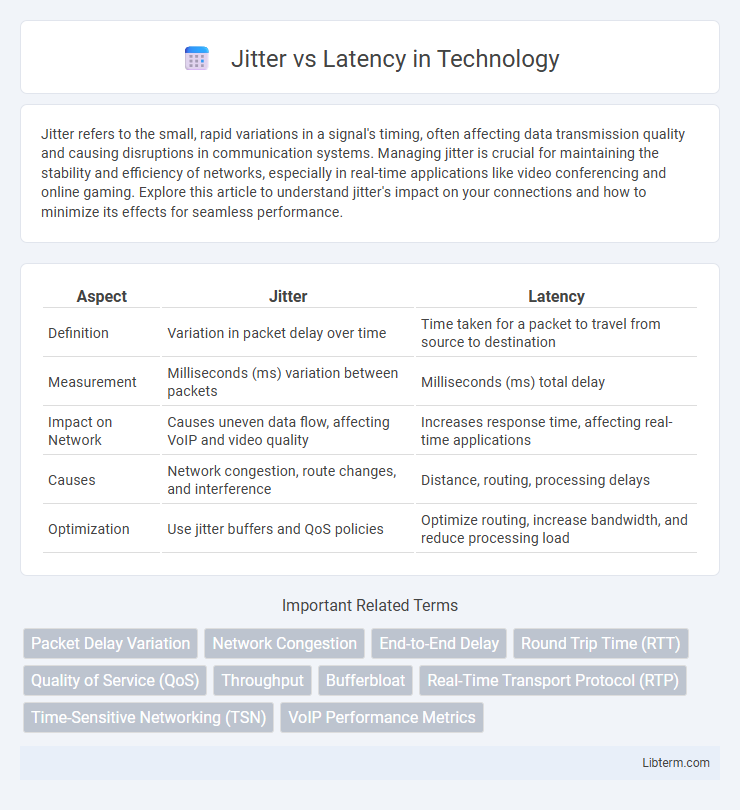Jitter refers to the small, rapid variations in a signal's timing, often affecting data transmission quality and causing disruptions in communication systems. Managing jitter is crucial for maintaining the stability and efficiency of networks, especially in real-time applications like video conferencing and online gaming. Explore this article to understand jitter's impact on your connections and how to minimize its effects for seamless performance.
Table of Comparison
| Aspect | Jitter | Latency |
|---|---|---|
| Definition | Variation in packet delay over time | Time taken for a packet to travel from source to destination |
| Measurement | Milliseconds (ms) variation between packets | Milliseconds (ms) total delay |
| Impact on Network | Causes uneven data flow, affecting VoIP and video quality | Increases response time, affecting real-time applications |
| Causes | Network congestion, route changes, and interference | Distance, routing, processing delays |
| Optimization | Use jitter buffers and QoS policies | Optimize routing, increase bandwidth, and reduce processing load |
Understanding Jitter and Latency: Key Concepts
Jitter refers to the variability in packet delay within a network, causing inconsistent timing in data transmission that affects real-time applications like VoIP and video conferencing. Latency is the total time it takes for a data packet to travel from the source to the destination, measured in milliseconds, and it impacts the responsiveness of network communication. Understanding both jitter and latency is crucial for optimizing network performance, ensuring smooth streaming, gaming, and low-latency communications.
What is Latency? Definition and Causes
Latency refers to the time delay between a user's action and the response from the system, typically measured in milliseconds (ms). It is caused by factors such as physical distance between devices, network congestion, routing inefficiencies, and processing delays in hardware or software. High latency can significantly impact real-time applications like online gaming, video conferencing, and VOIP calls by causing noticeable lag.
Demystifying Jitter: Meaning and Effects
Jitter refers to the variation in packet arrival times during data transmission, affecting the smoothness of real-time communication such as VoIP and video conferencing. Unlike latency, which measures the total delay, jitter causes irregular delays that can disrupt audio and video quality, leading to choppy calls or buffering. Managing jitter involves techniques like jitter buffering and quality of service (QoS) to stabilize packet flow and enhance overall network performance.
How Latency Impacts Real-Time Applications
Latency significantly affects real-time applications by causing delays between input and response, leading to decreased performance and user experience. High latency in video conferencing or online gaming results in lag, disrupting communication and gameplay flow. Minimizing latency is crucial for ensuring timely data transmission and synchronization in real-time systems.
The Role of Jitter in Network Performance
Jitter refers to the variation in packet arrival times, significantly impacting real-time applications like VoIP and online gaming by causing voice distortions and lag. Unlike latency, which measures the delay from source to destination, jitter affects the consistency of data flow, leading to packet loss and reduced quality of experience. Minimizing jitter through Quality of Service (QoS) protocols and jitter buffers is crucial for maintaining stable network performance and ensuring smooth multimedia streaming.
Jitter vs Latency: Main Differences
Jitter refers to the variability in packet delay within a network, while latency measures the total time it takes for a packet to travel from source to destination. High jitter can cause irregular packet arrival, negatively impacting real-time applications like VoIP and video calls, whereas high latency leads to overall slow response times. Understanding the distinction between jitter and latency is crucial for optimizing network performance and ensuring smooth data transmission.
Measuring Jitter and Latency: Tools and Methods
Measuring jitter and latency involves using network performance tools such as ping, traceroute, and specialized software like Wireshark or iPerf to capture packet delay variations and round-trip times accurately. Network analyzers measure latency by calculating the time a packet takes to travel from source to destination, while jitter is quantified by analyzing the variability in these latency measurements over time. Precision in these measurements is critical for optimizing real-time applications like VoIP and online gaming, where even milliseconds of deviation can impact user experience.
Common Causes of High Latency and Jitter
Network congestion, inefficient routing, and hardware limitations are common causes of high latency, resulting in delayed data transmission. Jitter often arises from inconsistent packet arrival times due to variable network traffic and buffer overflows. Both latency and jitter are exacerbated by inadequate bandwidth and improperly configured network devices, impacting real-time applications like VoIP and online gaming.
Solutions to Reduce Latency and Minimize Jitter
Reducing latency involves optimizing network infrastructure through the use of high-speed routers, fiber-optic connections, and edge computing to bring data processing closer to end-users. Minimizing jitter can be achieved by implementing Quality of Service (QoS) protocols, traffic shaping techniques, and deploying jitter buffers that smooth packet delivery variations. Combining these strategies ensures stable, low-latency communication critical for real-time applications like VoIP and online gaming.
Real-World Scenarios: Latency and Jitter in Action
In online gaming, latency refers to the delay between a player's input and the game's response, while jitter causes unpredictable spikes in that delay, resulting in inconsistent gameplay. Video conferencing suffers when high latency creates noticeable delays between speakers, and jitter leads to choppy audio or video by disrupting the steady flow of data packets. Streaming services rely on low latency for real-time interactions like live chats, but jitter can cause buffering and quality drops by unevenly spacing packet arrival times.
Jitter Infographic

 libterm.com
libterm.com